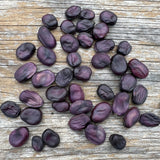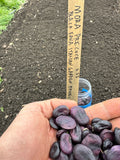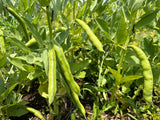Precoce Mora Fava
Vicia faba
This early purple-seeded fava bean comes to us from the Italian Garden Project who gathered them from Nicola Ranieri of Commack, Long Island. Born in Mola di Bari, Puglia, Nicola immigrated to the US in 1965. These are Nicola’s favorite fava because they flower before the weather warms enough in late spring to wilt the blooms. Produces many stalks from one seed and many large fava pods on each plant. Seed originally from Salerno, Italy.
This seed is part of the Italian Garden Project’s Italian American Collection. Read about our shared work HERE. Shop for more varieties in this special collection HERE.
This collection represents seeds from the most cherished vegetables of Italian immigrants, those flavors that just couldn't be left behind. Only the best of the best would have been deemed worthy of the passage from the Old World to the New. These are seeds which have been passed down through families for generations, saved from the most vigorous specimens hand-selected each season. When they arrived in America, they were lovingly propagated in backyard gardens and traded as valuable commodities within Italian communities.
Heirloom seeds such as these which have been nurtured over hundreds of years and traveled across continents are at risk of being lost and their histories forgotten. In order to safeguard these treasures, The Italian Garden Project has been seeking out these heirlooms from across the US and serving as their caretaker. And now our partnership with Truelove Seeds and their growers ensures that these unique varieties will continue to flourish and provide the authentic flavors of the past well into the future.
Days to maturity: 80-90
Seeds per pack: 18-24 minimum
Germination rate: 73% on 10/17/2024
Planting / harvesting notes
Direct sow in late winter or early spring when the soil is able to be worked. Favas prefer cool weather. Here in Philadelphia, we plant ours around St Joseph's day. Grow plants 8-10" apart. These short bushy plants may benefit from a trellis or pen to keep them from toppling as they develop their heavy pods. Do not handle the plants when wet from dew or rain, as this can spread disease. Pinch the new top growth when the plant is blooming to control aphids, which prefer the tender new leaves.
Seed keeping notes
Harvest the seeds when the pods have dried and turned black.









